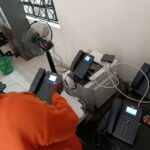Techniques Used By Hackers To Steal Passwords And How To Prevent Them
Brute Force Attack
A brute force attack is a common password-cracking technique that involves trying every possible combination of characters until the correct password is found. Hackers use specialized software to automate this process and can crack even complex passwords given enough time. Use strong and unique passwords with uppercase and lowercase letters, numbers, and symbols to prevent brute-force attacks. Implement password policies that require users to change passwords regularly and limit the number of unsuccessful login attempts before the account is locked.
Dictionary Attack
In dictionary attack, hackers use software that can try thousands of words per minute until the correct password is found. To prevent dictionary attacks, avoid using common words, phrases, or passwords that are easy to guess. Instead, use a combination of random characters, and don’t use the same password across multiple accounts.
Rainbow Table Attack
In rainbow table attack, hackers create a table of common passwords and their corresponding hashes, then compare the hashes of the target password to the table to find a match. To prevent rainbow table attacks, use a strong hashing algorithm.
Social Engineering
Social engineering involves manipulating people into revealing their passwords or other sensitive information. Hackers may impersonate a trusted person, send phishing emails, or use other tactics to trick users into giving up their passwords. Let us educate users on the risks of sharing passwords and sensitive information to prevent social engineering attacks. Use two-factor authentication (2FA) to add an extra layer of security and verify the identity of anyone asking for sensitive information.

Shoulder Surfing
Shoulder surfing is a physical attack that involves watching someone enter their password on a computer or mobile device. Hackers may look over someone’s shoulder in a public place or install a hidden camera to capture passwords. To prevent shoulder surfing attacks, be aware of your surroundings when entering passwords, and avoid entering passwords in public places. In addition, you can use a privacy screen to prevent others from viewing your screen and lock your device when not in use.
Phishing
Phishing is a technique that involves sending emails or messages that appear to be from a legitimate source to trick users into revealing their passwords or other sensitive information. Hackers use social engineering tactics and persuasive language to convince users to click on links or open attachments that install malware or steal data. To prevent phishing attacks, be cautious when opening emails or messages from unknown sources, and look for signs of phishing, such as misspellings or suspicious links. You can also use email filters to block suspicious messages and enable multi-factor authentication (MFA) to prevent unauthorized account access.
Keystroke Logging
Keystroke logging is a technique that involves capturing every keystroke entered on a computer or mobile device, including passwords. Hackers may install malware or use physical devices to capture keystrokes and steal passwords. To prevent keystroke logging attacks, use antivirus software and keep it up-to-date, avoid clicking on suspicious links or downloading software from untrusted sources, and use a hardware-based password manager to store passwords.
Malware
Malware is a type of software that is designed to harm or gain unauthorized access to a computer or network. Malware can be used to steal passwords, capture keystrokes, and perform other attacks. Keep your software and operating systems up-to-date with the latest security patches and updates to prevent malware attacks. Use antivirus software and keep it updated, avoid clicking on suspicious links or downloading software from untrusted sources, and be wary of emails or messages with attachments.
Man-in-the-Middle (MITM) Attack
A man-in-the-middle (MITM) attack is where a hacker intercepts communications between two parties to steal sensitive information, including passwords. Hackers use software or physical devices to intercept communications and capture passwords. To prevent MITM attacks, use secure communication channels, such as HTTPS or a virtual private network (VPN), when accessing sensitive information or logging into accounts. In addition, verify the identity of the website or service you are accessing, and be careful about unsecured or public Wi-Fi networks.
Some of the popular software tools used by hackers for brute force attacks and dictionary attacks include:
- Cain and Abel – a Windows-based password recovery tool that can crack passwords using brute force and dictionary attacks. It also includes a packet sniffer and other network analysis tools.
- John the Ripper – a command-line password cracking tool that can perform brute force attacks and dictionary attacks on various password hash formats. It can be used on Linux, Unix, Windows, and other operating systems.
- Aircrack-ng – a suite of tools for wireless network auditing that includes a password cracking tool for WEP and WPA/WPA2-PSK encryption. It uses brute force attacks and dictionary attacks to crack wireless network passwords.
- Hydra – a network logon cracker that supports various protocols, including HTTP, FTP, SSH, Telnet, and others. It uses brute force attacks and dictionary attacks to guess passwords for login credentials.
- Hashcat – a password cracking tool that can perform brute force attacks and dictionary attacks on various hash formats, including MD5, SHA1, and others. It can be used on Windows, Linux, and macOS.















